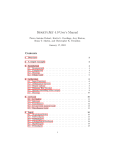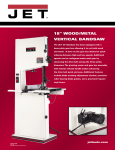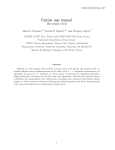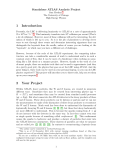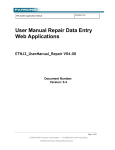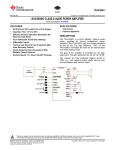Download SpartyJet User`s Manual
Transcript
SpartyJet User’s Manual
Pierre-Antoine Delsart, Kurtis Geerlings, Joey Huston,
Brian Martin, and Christopher Vermilion
February 9, 2011
Contents
1 Overview
2
2 Installation
2.1 Requirements . . . . . . . . . . . . . . . . . . . . . . . . . . . . .
2.2 Compilation . . . . . . . . . . . . . . . . . . . . . . . . . . . . . .
2.3 Running . . . . . . . . . . . . . . . . . . . . . . . . . . . . . . . .
2
2
3
4
3 A Simple Example
4
4 JetBuilder
4.1 Input Functions . . . . .
4.2 Minimum Bias Overlay .
4.3 JetTool Options . . . .
4.4 Constituents . . . . . .
4.5 Text File Output . . . .
5 JetTools
5.1 Selectors . . . . . . . .
5.2 Jet and Event Moment
5.3 Jet Substructure Tools
5.4 Miscellaneous Tools .
.
.
.
.
.
.
.
.
.
.
.
.
.
.
.
.
.
.
.
.
.
.
.
.
.
.
.
.
.
.
.
.
.
.
.
.
.
.
.
.
.
.
.
.
.
.
.
.
.
.
.
.
.
.
.
.
.
.
.
.
.
.
.
.
.
.
.
.
.
.
.
.
.
.
.
.
.
.
.
.
.
.
.
.
.
.
.
.
.
.
.
.
.
.
.
.
.
.
.
.
.
.
.
.
.
6
6
6
8
8
8
. . . .
tools
. . . .
. . . .
.
.
.
.
.
.
.
.
.
.
.
.
.
.
.
.
.
.
.
.
.
.
.
.
.
.
.
.
.
.
.
.
.
.
.
.
.
.
.
.
.
.
.
.
.
.
.
.
.
.
.
.
.
.
.
.
.
.
.
.
.
.
.
.
.
.
.
.
.
.
.
.
.
.
.
.
.
.
.
.
9
9
9
10
12
.
.
.
.
.
.
.
.
.
.
.
.
.
.
.
.
.
.
.
.
.
.
.
.
.
.
.
.
.
.
.
.
.
.
.
.
.
.
.
.
.
.
.
.
.
.
.
.
.
.
.
.
.
.
.
.
.
.
.
.
.
.
.
.
.
.
.
.
.
.
.
.
.
.
.
.
.
.
.
.
.
.
.
.
.
.
.
.
.
.
.
.
.
.
.
.
.
.
.
.
.
.
.
.
.
.
.
.
.
.
.
.
.
.
.
.
.
.
.
.
.
.
.
.
.
.
.
.
.
.
.
.
.
.
.
.
.
.
.
.
13
13
14
15
15
15
16
16
6 Input
6.1 NtupleInputMaker . . .
6.2 StdTextInput . . . . . .
6.3 StdHepInput . . . . . .
6.4 CalchepPartonTextInput
6.5 HepMCInput . . . . . .
6.6 PythiaInput . . . . . . .
6.7 Input Options . . . . . .
.
.
.
.
.
.
.
.
.
.
.
.
.
.
.
.
.
.
.
.
.
.
.
.
.
.
.
.
.
.
.
1
7 Output
16
7.1 Output variable type . . . . . . . . . . . . . . . . . . . . . . . . . 17
7.2 Constituents . . . . . . . . . . . . . . . . . . . . . . . . . . . . . 17
8 Analysis
1
17
Overview
SpartyJet is a set of software tools for jet finding and analysis, built around
the FastJet library of jet algorithms. Besides physics motivations, it has been
written with three goals in mind:
• ease of use
• flexibility
• extensibility
To meet these goals, SpartyJet is modular: it consists of bricks of software
put together allowing one to:
• access a wide variety of input formats
• perform any operation on this input, including jet finding, modification,
and measurement
• save all results and any associated quantities in a ROOT TTree
SpartyJet extends basic jet finding with a large library of built-in jet tools
to implement input and output cuts, jet modifications such as filtering and pileup subtraction, and jet measurements (“moments”) that can be calculated for
every jet and stored in the output file. A typical SpartyJet analysis consists
of a script that describes a set of jet algorithms, each with a set of jet tools
that modify and measure the found jets. Section 3 walks through a simple
example. In addition, a graphical interface is in development that allows the
user to explore jet analyses interactively.
2
2.1
Installation
Requirements
OS Most Linux distributions, Mac OS X, Cygwin presumably possible but not
tested.
Compiler Tested with gcc; built with make.
ROOT Recent version, tested with 5.26, but older versions probably OK.
2
FastJet (included) Relies on FastJet for most jet finding and some internal
features. Can link against an external copy or build the built-in version.
Python (optional) Python, 2.4 or later — not necessary but highly recommended. The Python interface uses PyROOT, so you must have built
ROOT with this enabled. (We anticipate that the Python interface will
migrate to SWIG instead of PyROOT with a future release.)
Fortran compiler (optional) Needed to compile the libraries allowing StdHep reading. Tested with gfortran.
2.2
Compilation
To compile:
# Setup ROOT such that root-config is in your path
# for example source root/bin/thisroot.sh
cd spartyjet
source setup.sh
make
• Options: SpartyJet has several building options to note:
1. FastJet: SpartyJet depends on FastJet for jet finding and some
internal features, and the latest version is included in the SpartyJet
distribution. If you prefer to use your own installation, simply add
your-fastjet/bin to the environmental variable $PATH such that
fastjet-config can be found.
NOTE: If you have linking problems between your version of FastJet and SpartyJet, either recompile your FastJet with the --with-pic
option enabled before compilation, or allow SpartyJet to compile
its own version. Note also that to enable all FastJet plugins, you
must pass the --enable-allcxxplugins flag to configure. This is
done by default for the built-in version.
2. StdHEP libraries: These require a FORTRAN compiler and are automatically compiled if you have gfortran,f77, or g77 in your $PATH.
If you would like to try a different compiler, set the environmental
variable $F77 to the compiler binary.
3. Pythia 6/8 interface: If you have ROOT compiled with the Pythia
6 andor Pythia 8 interfaces enabled, you can use this from within
SpartyJet to generate events in Pythia and feed the output directly
to SpartyJet. To enable this, set the variable $PYTHIA6DIR andor
$PYTHIA8DIR If you do not have PYTHIA support in ROOT, you can
add it by doing:
cd $ROOTSYS
./configure --enable-pythia6 --enable-pythia8
3
--with-pythia6-libdir=/my/pythia6/
--with-pythia8-incdir=/my/pythia8145/include/
--with-pythia8-libdir=/my/pythia8145/lib/
make
• Libraries: This will build a set of libraries in spartyjet/libs that you
can load from a ROOT session or Python script, or you can link to to
build an executable.
libs/libFastJetCore.so
- FastJet code and some wrappers
libs/libJetCore.so
- Core infrastructure
libs/libIO.so
- Facilities for reading and writing a variety of file formats
libs/libFastJet.so
- Tools that rely on FastJet, including jet fnding
libs/libJetTools.so
- Other JetTools
libs/libEventShape.so
- Thrust and other eventshapes
libs/libSpartyDisplay.so - SpartyJet GUI
libs/libExternalTools.so - A set of external jet tools, with wrappers
2.3
Running
Working examples of how to use SpartyJet can be found in the following
directories:
spartyjet/examples_py : Python scripts (recommended)
spartyjet/examples_C
: ROOT scripts and compiled programs, in C++
The Python interface to SpartyJet is strongly preferred, and C++ access
may be deprecated in a future release. We are also planning to switch from
PyROOT to SWIG for Python access to SpartyJet libraries, with ROOT
only used for output. To use the Python scripts, some environment variables
needs to be set, which can be accomplished via:
source setup.sh
in the spartyjet/ directory. This exports the relevant paths to your LD LIBRARY PATH
and sets the environment variable SPARTYJETDIR, which allows the SpartyJet
Python modules and libraries to be accessible from any directory. The relevant
lines of setup.sh could also be copied into your shell’s rc file, e.g. ~/.bashrc.
3
A Simple Example
The simplest way to get a feel for how SpartyJet works is to consider an example; in this section we walk through the script spartyjet/examples_py/simpleExample.py.
This script runs the anti-kT algorithm on the first 10 events listed in data/J1_Clusters.dat,
makes a simple measurement on the found jets, and stores the results.
• Load the libraries that are needed for the algorithms that you are running (you need to source setup.sh in the main directory first to set up
environment variables):
4
from
Sp ar ty J et Co nf i g import *
• Create a JetBuilder object to manage SpartyJet jobs. The argument
sets the output message level — options are {DEBUG, INFO, WARNING,
ERROR}. Log messages throughout the code are tagged with a message
level; messages with level lower than the current output level are suppressed. Note that the SpartyJet namespace is loaded as SJ.
builder = SJ . JetBuilder ( SJ . INFO )
• Create an input object of type StdTextInput with the filename containing
the events. Many types of input are available; see Section 6.
input = SJ . StdTextInput ( ’ data / J1_Clusters . dat ’)
builder . c o nf ig u re _i np ut ( input )
• Define the jet algorithm(s) that you want to run. Most algorithms are
implemented in FastJet via the FastJetFinder tool. The three arguments are a name for the tool, the algorithm’s FastJet enumeration
in fastjet::JetAlgorithm, and the R parameter. You can also pass
your own fastjet::JetDefinition, including a plugin algorithm; see
FJExample.py for examples. Note that the fastjet namespace is loaded
as fj.
name = ’ AntiKt4 ’
alg = fj . a n t i k t _ a l g o ri t h m
R = 0.4
antikt4 = SJ . FastJet . FastJetFinder ( name , alg , R )
• Pass algorithm to your JetBuilder. This sets up a JetAlgorithm object,
which holds a chain of JetTools to be executed.1 A jet finder is one
example of a JetTool; see Section 5 for many more. add default alg()
adds some default tools before and after the jet finder passed (currently
negative energy correctors, if enabled). add custom alg() inserts a userprovided JetAlgorithm.
builder . a d d_ de f au lt _a l g ( antikt4 )
• Insert another tool in the chain, in this case making a measurement of
jets’ angular moments in η and φ. These will also be stored in the output
ROOT file. add jetTool() can take a second argument, the name of an
algorithm to add the tool to; otherwise the tool is added to all algorithms.
builder . add_jetTool ( SJ . E t a P h i M o m e n t T o o l () )
• Configure (optional) simple text output for quick visual check of results.
builder . a d d_ te x t_ ou tp ut ( ’ data / output / text_simple . dat ’)
1 JetAlgorithm is an awkward name for this object; something like JetToolChain would be
more accurate. The name will likely change in a future release.
5
• Configure the Ntuple output by specifying the name of the tree and the
ROOT file you want the data to be stored in. This output can be manipulated via your own ROOT scripts or be viewed with the SpartyJet GUI
— see guiExample.py.
builder . c o n f i g u r e _ o u tpu t ( ’ Spar tyJet_Tr ee ’ , ’ data / output / simple . root ’)
• Give the command to run the algorithms on the first 10 events
builder . proc ess_even ts (10)
Running the script will process the first 10 events on the file specified in
the input object and produce the .root file specified in configure output. To
view the output with the GUI, run
examples_py/guiExample.py data/output/simple.root
from the main directory. This is meant as a basic introduction, and there are
many more functions than listed here. See the other examples for more.
4
JetBuilder
JetBuilder is the job manager for SpartyJet. JetBuilder takes the input from an InputMaker (see Section 6) and passes it through a sequence of
JetTools. A sequence of JetTools makes up a JetAlgorithm. The final list of
jets, and associated moments, is passed to an NtupleMaker, which prepares the
output. This is shown schematically in Fig. 1.
4.1
Input Functions
Example: examples_py/inputExample.py
Input is passed to JetBuilder via:
builder . c o nf ig ur e _i np ut ( input )
where input can be any class deriving from InputMaker. See Section 6 for
examples.
4.2
Minimum Bias Overlay
Example: examples_py/overlayExample.py
JetBuilder allows the user to add minimum bias (MB) events to the signal
events to study the effects of pileup. To enable MB events, one must:
1. Create another input object:
MBinput = SJ . StdTextInput ( ’ ../ data / MB_Clusters . dat ’)
2. Tell JetBuilder to add n MB events to each signal event:
builder . a d d _ m i n b i a s _ e ve n t s (n , MBinput )
6
JetBuilder (job manager)
InputMaker
input tools (common to all JetAlgorithms)
JetTool
JetTool
JetTool
Input file
JetAlgorithm
JetAlgorithm
JetAlgorithm
JetTool
JetTool
JetTool
JetTool
JetTool
JetTool
JetTool
JetTool
JetTool
JetTool
JetTool
JetTool
...
...
...
NTupleMaker
Output ROOT file
Figure 1: The structure of a SpartyJet analysis. A JetBuilder gets input
from a file using an InputMaker, passes the input through a sequence of input
JetTools, and passes the output to several JetAlgorithms. JetAlgorithms
consist of a sequence of JetTools that are run sequentially. The output of
each JetAlgorithm is passed to an NTupleMaker which stores the final jets and
accompanying moments in a file.
7
...
JetBuilder will start at the beginning of the MB data file and read the first n
events for the first data event, then the second n events for the second data event,
so on. When the end of the MB file is found, it will simply continue from the beginning. There is a third optional Boolean argument to add minbias events()
that tells JetBuilder whether to draw the number of MB events from a Poisson distribution. In this case, n is the Poisson mean or expected number of MB
events.
4.3
JetTool Options
JetTools are blocks of code that act on a set of Jets — implemented as a
JetCollection. A set of JetTools forms a JetAlgorithm, and a JetBuilder
holds a set of JetAlgorithms that are each run on its inputs. Examples of
specific tools can be found in the JetTools section.
JetAlgorithms are added to the via:
builder . a d d_ de fa u lt _a lg ( tool )
where tool is a single JetTool, typically a jet finder, which forms the basis
of the tool chain. Default tools are added before and after — currently just
negative energy correctors, if this option is enabled.
Alternatively, to add a JetAlgorithm, possibly with multiple JetTools already associated with it:
builder . add_c ustom_a lg ( alg )
JetTools are added to the execution sequence via:
builder . add_jetTool ( tool )
or to the front of the sequence with:
builder . a d d _ j e t T o o l _ f r o n t ( tool )
These add the specified JetTools to all JetAlgorithms. A second, string argument may be passed to these methods specifying which JetAlgorithm the tool
should be added to.
A single sequence of JetTools is run on the input particles before they are
passed to each JetAlgorithm. This sequence starts empty; to add to it use:
builder . a d d _ j e t T o o l _ i n p u t ( tool )
This is useful for initial tools like pT and η cuts that are common to all algorithms.
4.4
Constituents
SpartyJet retains information about each jet’s full recombination history. The
method by which this information is stored is explained in Section 7. By default,
this is enabled; to disable history saving, you must add false as a second
argument:
builder . a d d_ de fa u lt _a lg ( alg , False )
The full recombination history is stored in memory, but storage to disk has
not yet been implemented. We hope to have this available in the near future.
8
4.5
Text File Output
The text file output option tells JetBuilder to produce an easily-readable text
file that contains a list of all jets found from all algorithms for all events. To
turn on the text file output, you must call builder.add text output(), and
pass it the filename you want to create. For example:
builder . a d d_ te xt _ ou tp ut ( ’ ../ data / output / text_output . dat ’)
5
JetTools
JetTools are blocks of code that act on a JetCollection for every event. They
generally perform one or more of the following functions:
• Add or remove jets from the list.
• Modify the jets themselves.
• Add information about each jet as a JetMoment.
• Add information about each event as an EventMoment.
Jet tools can be added either before or after the primary jet finder (e.g. kT
algorithm) in the JetAlgorithm. The following is a list of JetTools shipped
with SpartyJet. The relevant definitions can be found in JetTools/.
5.1
Selectors
These tools allow the user to remove some Jets from an input/output JetCollection, and are defined in JetTools/JetSelectorTool.hh.
JetPtSelectorTool(double ptmin) - Removes jets with pT below cut.
JetPtORESelectorTool(doule ptmin, double emin) - Removes jets with pT
or energy below cuts.
JetEtaCentralSelectorTool(double abs eta) - Removes jets outside of central η region.
JetEtaForwardSelectorTool(double abs eta) - Removes jets inside of central η region.
JetMassSelectorTool(double mass) - Removes jets with m below cut.
JetInputPdgIdSelectorTool(std::vector<int> pdgIds) - Removes input
“jets” with given PDG IDs. (Useful when the input jets are just single
particles from a Monte Carlo where leptons, neutrinos, etc. are included.)
JetMomentSelectorTool<T>(std::string momentName, T min, T max) - Finds
the given jet moment (calculated by another tool) and requires it be within
(min, max). T can be any type supporting less-than comparison.
9
5.2
Jet and Event Moment tools
These tools calculate moments for each jet or event, which can be any type
that ROOT knows how to store, most commonly floats or ints. The generic
JetMomentTool and EventMomentTool calculate and store any user-implemented
JetMoment<T> or EventMoment<T> object. See JetTools/JetMomentTool.hh
for some specific examples, and FJToolExample.py for moment tools in action.
The following are other moment-storing tools available in SpartyJet:
HullMomentTool This tool finds the convex hull enclosing each jet and saves
the hull length and area as Hull and HullA respectively.
EtaPhiMomentTool This tool calculates angular second moments in η and φ of
each jet stores them as M2eta and M2phi.
PtDensityTool This tool calculates each event’s pT density using FastJet.
It does this by finding all the jets in the event with no minimum pT
requirement. It then extracts the pT density from these jets by selecting
the mean pT density for each bin in η. These pT densities are stored as
ptDensity and the η bin limits are stored as ptDensityBins.
JetAreaCorrectionTool This tool uses the area of each jet and the pTDensity found by the PtDensityTool to calculate a correction (stored as jet
moment JetAreaCorr) to the jet’s pT .
YSplitterTool This tool uses FastJet to calculate the y values associated
with a set of recombinations. In this implementation, SpartyJet will run
a FastJet algorithm of the user’s choice on the constituents of a given
jet. It can be called with either of the following constructors:
YSplitterTool ( float R , fastjet :: JetAlgorithm alg , int ny , int njet )
YSplitterTool ( fastjet :: JetDefinition * jet_def , int ny , int njet )
where njet is the number of jets for which the y values will be calculated
and ny is the number of y values to calculate for each jet.
5.3
Jet Substructure Tools
Several tools to modify jet substructure have recently been proposed, and many
have now been incorporated into SpartyJet. Some are implemented natively;
some are essentially wrappers for existing FastJet tools. External tools that
are not part of FastJet are included in the external/ directory. Currently
all of these external tools are available on the FastJet website. The file
external/README notes which files are external and where they came from.
These tools are in active development, should be considered “beta”, and are
subject to change in syntax and behavior. User feedback on which features are
most useful, which tools are missing, etc. is strongly encouraged. Examples of
how to use these tools can be found in examples_py/FJTool.py.
10
TopDownPruneTool This is a generic tool implementing the “pruning” away of
asymmetric branchings that is the first step in several recent substructure
methods. Derived classes implement the branch test() method to test
if a branching represents a symmetric branching (found two subjets), an
unresolved branching (e.g., the two subjets are too close together — found
one subjet), or an asymmetric branching, where one subjet is discarded
and the procedure recurses on the other subjet. The user can specify how
many splittings to look for — one splitting will yield up to two subjets, two
splittings yields up to four, etc. Two specific examples are implemented:
JHPruneTool and MassDropTool. The former reproduces the first step in
the Johns Hopkins top-tagging method (arXiv:0806.0848); the latter reproduces the mass-drop step in the the Higgs analysis of arXiv:0802.2470.
See JetTools/TopDownPruneTool.hh. The constructors are:
JHPruneTool ( double delta_p = 0.1 , double delta_r = 0.19 , int max_split
= 2 , string name = " JHPrune " )
MassDropTool ( double mu_cut = 0.67 , double ycut = 0.09 , int max_split =
1 , string name = " MassDrop " )
max split is the number of recursions to allow looking for symmetric splittings. max split = -1 continues until all branchings are unresolved. Note
that this implementation of the Johns Hopkins pruning step is slightly different than the original, in that asymmetric branchings below the main
splitting are discarded even if no subsequent symmetric splitting is found.
SubjetCutTool The various implementations of TopDownPruneTool all store a
jet moment for the number of subjets found. This simple selector tool cuts
on the number of subjets found by a given tool, and optionally unclusters
the jet such that the last merging is N → 1 if N subjets are required.
Construct with:
SubjetCutTool ( T o p D o w n P r u n e T o o l * subjet_tool , int Nsubjets = 2 , bool
uncluster = false , string name = " SubjetCut " )
SubjetMergeTool If something like SubjetCutTool has been used to identify
more than two subjets of the final jet, this tool merges the two whose
combined mass is closest to a given value (mW , say, for a top jet). If
the final merging is N → 1, this inserts a 2 → 1 merging followed by
(N − 1) → 1. A variant of this tool is MinMassTool, which merges the
two subjets with minimum combined mass and therefore does not shape
the background distribution as strongly. The constructors are:
S ub je tM e rg eT oo l ( double m , string name = " S u bj et Me r ge To o l " )
MinMassTool ( string name = " MinMassTool " )
FilterTool and BDRSFilterTool These wrap the Filter and FilteredJet
classes written by Gavin Salam to implement jet “filtering”, as in the final
step of the Higgs analysis in arXiv:0802.2470. Both assume that their
input JetCollection holds jets found with Cambridge/Aachen. Filtering
unclusters these jets down to some angular scale Rfilt and keeps the
11
hardest nfilt as well as any above a pT cut ptkeep. Each jet in the input
is filtered and copied into the output JetCollection. For FilterTool
the Filter is created once and used for all jets; for BDRSFilterTool
the filter is recreated for each jet, using Rfilt = min(Rfilt , ∆R12 /2). The
constructors are:
FilterTool ( fastjet :: Filter * filt , double R = 1.0 , string name = "
FilterTool " )
BDRSF ilterTo ol ( double R = 1.0 , double Rfilt = 0.3 , int nfilt = 3 ,
double ptkeep = numeric_limits < double >:: max () , double rho = 0. ,
string name = " BDRSFilter " )
If rho is non-zero, area-based subtraction is also performed. The R parameter in the constructors should be the R parameter the jets were found
with; the algorithm is not re-run. See external/Filter.hh.
TopTaggerTool This tool uses a provided top-tagging class to select jets and
identify their subjets. In the current implementation, TopTaggerTool is
templated with a top-tagger class, and will work with either JHTopTagger
or CMTopTagger, both external tools. JHTopTagger implements the Johns
Hopkins top-tagging method of arXiv:0806.0848; CMTopTagger is an alternative (unpublished) method by Gavin Salam. TopTaggerTool uses the
common functions maybe top() (determines whether the jet is “tagged”),
W subjet(), and subjets(). The stored jet is taken to be the sum of
subjets(), with the two subjets: the jet returned by W subjet() and the
full jet minus the W . No further substructure is stored (this is not yet
available in CMTopTagger). The value of the function cos theta h() is
stored as the jet moment "cosThetaH". The constructor is:
TopTaggerTool ( Tagger * tagger , string name = " TopTagger " )
Note that in Python you must supply the template argument:
JHtool = SJ . FastJet . TopTaggerTool ( fj . JHTopTagger ) ( JHtagger )
The constructors for the top taggers are:
JHTopTagger ( double delta_p = 0.10 , double delta_r = 0.19 , double mW =
81.0)
CMTopTagger ( double zmin = 0.0 , double mass_max = 0.0)
Note that the implementation of these taggers has been changed slightly
for inclusion in SpartyJet: they are set up to be constructed once and
run multiple times, so the original constructors have been split into new
constructors taking parameters, and a run(ClusterSequence*, PseudoJet&)
step that runs the tagger on a given jet.
WTaggerTool This tool wraps the W -tagging method of Cui, Han, and Schwartz
arXiv:1012.2077, which includes a large number of substructure and mass
cuts. The cuts are taken from data files in external/wtag-1.00/data.
So far there is no way to re-train the cuts from within SpartyJet— the
idea is to take a pre-trained W -tagging method and plug it into a SpartyJet analysis. Since the tagger is taken “out-of-the-box”, there are no
input parameters:
12
WTaggerTool ()
5.4
Miscellaneous Tools
ForkToolParent and ForkToolChild This pair of tools allows the forking of
JetTool chains. ForkToolParent merely saves a copy of its input. A
ForkToolChild is associated with a specific parent, and it reads in the
JetCollection saved by its parent. This allows, for example, one jet
algorithm to be run combined with several different jet-modifying tool
chains for comparison. See FJToolExample.py for a usage example.
CalorimeterSimTool This tool applies a very simple calorimeter simulation to
its input jets. Inputs are sorted into calorimeter cells on a specified η–φ
grid. For each non-empty cell, a massless output particle is created with
the direction of the cell and the total energy of all particles in the cell.
JetNegEnergyTool This tool is meant to be run twice: once before jet finding
and once afterward. On first run, the tool finds and stores all input particles with negative energy. For each such particle it inverts the energy to
be positive. On second run, the JetNegEnergyTool loops over jets, and
for each constituent that initially had a negative energy, it corrects the
jet energy by subtracting twice the constituent’s (positive) energy. The
JetBuilder method do correct neg energy(true) inserts this pair of
tools before and after all jet finders added with add default algorithm(tool);
by default this is not done.
EConversionTool This tool simply converts the units of all the jets between
MeV and GeV. The user can convert to arbitrary units as well.
6
Input
All SpartyJet jobs need an InputMaker object to read input from some data
file and prepare a list of 4-vectors for JetTools to process. There are several
types of InputMakers available. An example of the implementation for each type
of input can be seen in examples_py/inputExample.py. For Python scripts,
the utility module python/SpartyJetConfig.py defines the helper function
getInputMaker(fileName) which will create the appropriate InputMaker by
looking at the filename extension.
6.1
NtupleInputMaker
Sample: data/J2_clusters.root
This form of input reads ROOT files. This InputMaker requires the components of the input 4-vectors to be stored in separate branches of a ROOT
TTree. The following definitions are supported:
• px, py, pz, E
13
• (psuedo)rapidity, phi, pt, E
• (psuedo)rapidity, phi, pt, m
You need only specify how the information is stored (array or vector / float or
double) and the names of the branches.
As an example, to set up an NtupleInputMaker to read the file data/J2_clusters.root,
if you don’t know how variables are internally stored in your ntuple, do the following:
root -l data/J2_clusters.root
root [0] clusterTree->MakeClass("test");
Open the file test.h and check to see how the variables are stored. In this
example, we see lines like:
vector < float > * Cluster_eta ;
indicating that our 4-vectors are stored in vectors of floats. Now to configure
SpartyJet to accept this, we need to:
• Create an NtupleInputMaker of the correct type: (in our case: vector<float>
for (eta, phi, pt, E)).
input = SJ . N t u p l e I n p u t M a k e r ( SJ . N t u p l e I n p ut M a k e r . E t a P h i P t E _ v e c t o r _ f l o a t )
For full list of Input codes see: JetCore/InputMaker_Ntuple.hh
• Configure the names of the TBranches
input . set_prefix ( ’ Cluster_ ’)
input . set_n_name ( ’N ’)
input . set_variables ( ’ eta ’ , ’ phi ’ , ’ p_T ’ , ’e ’)
input . setFileTree ( ’ ../ data / J2_clusters . root ’ , ’ clusterTree ’)
• Specify if input is massless, only useable in eta,phi,pt,E mode (if true,
pt is ignored):
input . s e t _ m a s sl e s s M o d e ( True )
• Set the input file and tree names:
input . setFileTree ( ’ ../ data / J2_clusters . root ’ , ’ clusterTree ’)
Python Shortcut:
To allow SpartyJet to configure your Ntuple using some assumptions use
the following helper function:
input = c r e a t e N t u p l e I n p u t M a k e r ( ’ ../ data / J2_clusters . root ’ , inputprefix = ’
Cluster ’)
DelphesInput
DelphesInputMaker is a minor extension of NTupleInputMaker that reads the
ROOT files produced by the detector simulator Delphes. Only calorimeter
cells are read in.
14
6.2
StdTextInput
Sample: data/J1_Clusters.dat
This form of input reads ASCII files. To separate events, put one of the
following lines between the events:
.Event
.event
N
n
(only the .E or .e is important in the first two).
The form of the four vectors should be:
E px py pz
This input is configured simply with:
input = SJ . StdTextInput ( ’ ../ data / J1_Clusters . dat ’)
If the form is the opposite (px py pz E), then call the function
input . i n v e r t _ i n p u t _ o r d e r ( True )
and it will be read in properly.
An example of this input can be seen in data/J1_Clusters.dat
6.3
StdHepInput
Sample: data/ttbar_smallrun_pythia_events.hep
This form of input reads StdHEP format XDR files. It will look for particles
with the status code of 1 (final state). It is also able extract the PDG ID code
for each particle from the input data to allow further filtering and matching.
Access to intermediate particles such as the participants in the hard scattering,
or B hadrons from b quark decays, should be possible in the near future.
This input is configured simply with:
SJ . StdHepInput ( ’ ../ data / t t b a r _ s m a l l r u n _ p y t h i a _ e v e n t s . hep ’)
NOTE: To read StdHep files, you must enable StdHep compilation as explained in Section 2.2.
6.4
CalchepPartonTextInput
Sample: data/gg_ggg_events.dat
This form of input reads output from CalcHEP. It reads in the number of initial and final state particles, and then for each event saves only the information
for the final state particles.
This input is configured simply with:
SJ . C a l c h e p P a r t o n T e x t I n p u t ( ’ ../ data / gg_ggg_events . dat ’)
15
6.5
HepMCInput
Sample: data/HepMC_sample.dat
This form of input reads HepMC (version 2) format ASCII files. HepMC
ASCII files contain the following separators:
E - Denotes new event
V - Information about a vertex
P - Information about a particle
This class reads in the 4-vectors of the particles denoted with a status code
of 1 (not decayed, final state).
6.6
PythiaInput
This form of input generates and reads events directly from Pythia, without
ever having to write them to a file. This requires ROOT’s Pythia interface;
versions 6 and 8 will both work. See examples_py/pythiaExample.py for an
example of using Pythia in this way.
6.7
Input Options
Multiple input files
The MultiInput class can be used to string a set of input files together. See
examples_py/mergedInputExample.py for an example. Note that the current
implementation opens all input files before beginning, which may be inefficient.
Rejecting bad input
The InputMaker can be set to remove 4-vectors with negative energy and nonphysical momenta by using the following function.
input . r e j e c t _ b ad _ i n p u t ( bool )
The current default is false; no checks will be done. (An alternative to this
method of dealing with bad input is to use the JetNegEnergyTool, described
in the JetTools section.)
Reading of PDG ID codes
The InputMaker can be set to read PDG ID codes from the input data with
the following function. This is done by default.
input . readPdgId ( bool )
This makes the PDG IDs available for input selection and saves the IDs of the
input particles for offline analysis.
16
7
Output
When using the JetBuilder class the result is a ROOT Ntuple containing jet
variables for each algorithm added, plus variables for input particles to the jet
algorithms. Jet and event moments are also stored in a similar way.
7.1
Output variable type
It is possible to choose the type of the variable saved in the Ntuple built by
JetBuilder. Choice are between pure C array or STL vector of floats or doubles.
builder . o u t p u t _ v ar _ s t y l e . array_type = ’ vector ’ # ( default ) other option is "
array "
builder . o u t p u t _ v ar _ s t y l e . base_type = ’ float ’ # ( default ) other option is "
double "
7.2
Constituents
For all algorithms, constituent information can be saved as follows. Assuming
an algorithm named MyJet has been added, two additional variables are stored
in the ROOT TTree:
MyJet numC
MyJet ind
MyJet numC is an array of size MyJet N. MyJet numC[i] is the number of
constituents of i th jet. MyJet ind is an array of size InputJet N. MyJet ind[i]
is the index of the jet to which the i th input constituent has been assigned.
For example:
myTree . Draw ( ’ InputJet_e ’ , ’ AntiKt10_ind ==0 ’)
will give the energy distribution of constituents in jet number 0 (i.e. highest pT
jets) for the AntiKt10 collection.
8
Analysis
A graphical user interface is under development for interactive SpartyJet analysis. Users can test this out with the guiExample.py in the examples_py directory. A screenshot of the GUI in action is shown in Fig. 2. The user can
select which algorithms to view by ticking the boxes under “JetCollections”.
On the left are several event-by-event views, which will be drawn separately
for each algorithm. The number of rows and columns are set in the upper left.
Additional algorithms can be run (event-by-event) on the fly using the menu in
the lower left.
On the right, full-run plots can be selected, which are plotted for all algorithms together (an example of this output is shown in Fig. 3). Check boxes are
provided for the standard four-momentum variables, but any stored jet moment
can also be plotted by entering the name in the box below, e.g. $$_subjetM to
plot the subjet mass if the HeavierSubjetMass moment has been used. Note
17
that $$ is a placeholder for the algorithm name. Cuts can be added using TCut
syntax, e.g. AntiKt10_mass > 150 && AntiK10_mass < 200. Finally, legend
labels for each algorithm can be given; the syntax is ROOT TLatex text, e.g.
#phi {0} produces φ0 .
Figure 2: A screenshot of the SpartyJet graphical interface.
Contact information
Any questions/comments/suggestions, email:
Pierre-Antoine Delsart: delsart@ in2p3.fr
Joey Huston:
huston@ pa.msu.edu
Brian Martin:
marti347@ msu.edu
Chris Vermilion:
verm@ uw.edu
18
Number of jets
Pruned
Anti-kT
Filtered
700
600
500
400
300
200
100
0
0
20
40
60
80
100
mass
Figure 3: An example canvas produced by the run plot option (above), with the
options that produced it (below).
19



















